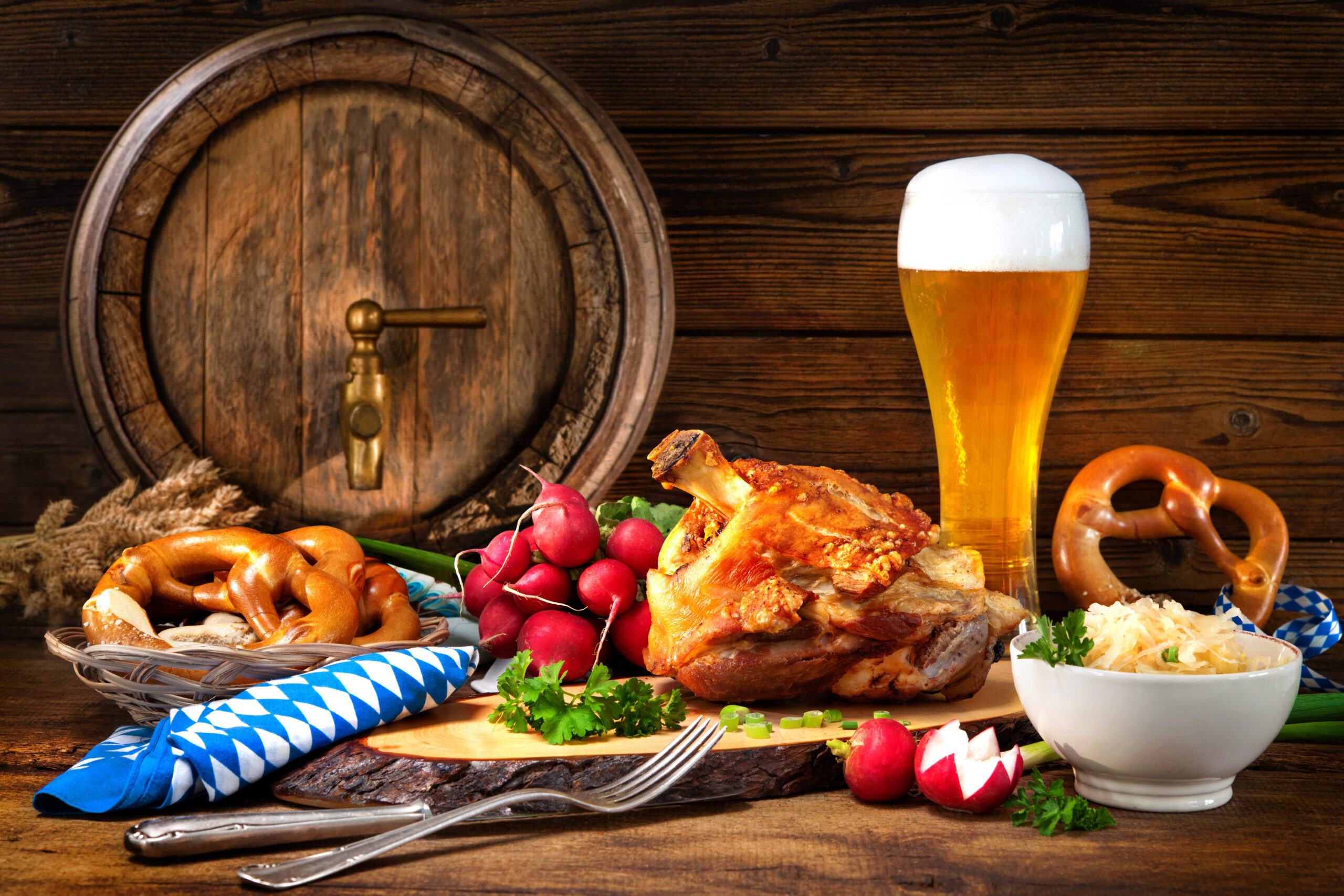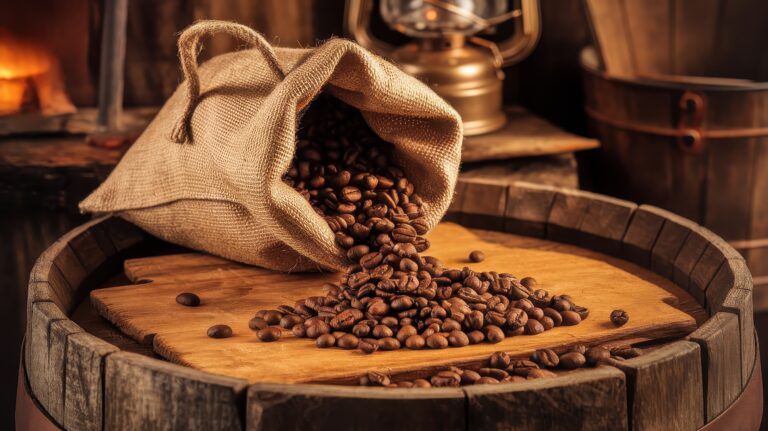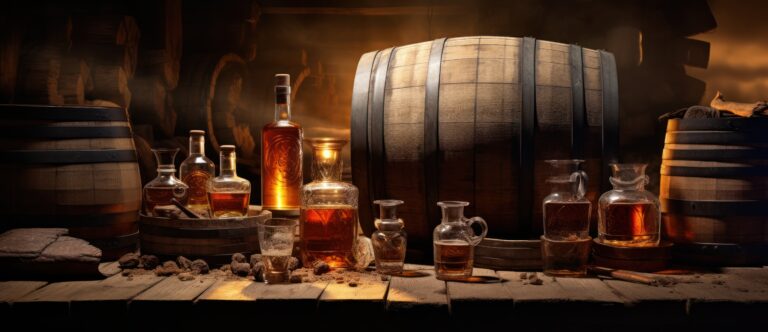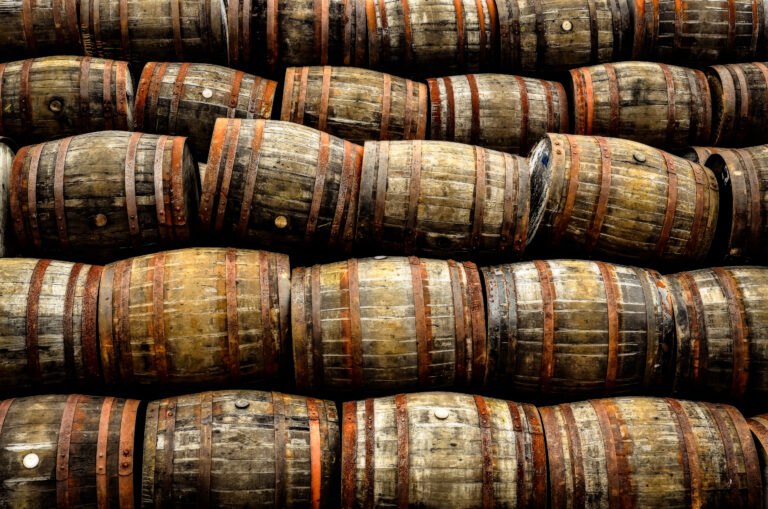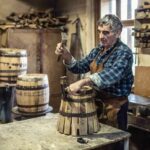Ever wonder why that smoky steak or a piece of rich dark chocolate tastes so incredible with a good glass of whiskey? It’s all thanks to the barrel-aging process. As whiskey matures inside a charred oak barrel, it doesn’t just sit there—it absorbs a whole spectrum of flavor compounds that just happen to be the perfect match for many of our favorite foods.
Think of it like this: The whiskey and the wood are having a conversation. Over time, the spirit pulls out beautiful, aromatic notes like vanilla, caramel, and various spices. That toasted, charred inner layer of the barrel adds a little something extra, too—a hint of toast and smoke. All of these elements work together, giving the whiskey its smooth, complex character. When you take a sip, you’re tasting that harmonious blend of hundreds of different flavor molecules.
This same principle is what makes pairing food and whiskey so exciting. When you combine a barrel-aged whiskey with something that has complementary flavors and aromas—like dark chocolate, aged cheese, or grilled meat—it’s like they’re singing in unison. Understanding how these whiskey barrels shape the flavor is the key to unlocking a world of delicious culinary possibilities. Your next bite or sip might just lead to your new favorite pairing. Ready to start experimenting?
History of Barrel Aging and How It Impacts Flavor
The art of barrel aging alcohol is a centuries-old tradition. Wooden barrels, especially those made from oak, don’t just hold the spirit—they’re an active ingredient that imparts both flavor and color. Whiskey is a prime example of this transformative process. As it rests in a charred oak barrel, it absorbs compounds like vanillin, which gives it that distinct, delicious taste and aroma we all love.
History of Barrel Aging
While wooden barrels have been used since the days of the Roman Empire, whiskey distillers didn’t start using charred oak casks until the 19th century. This was a game-changer. The interaction between the spirit and the wood mellowed the whiskey’s harshness and allowed it to develop incredible notes of vanilla, caramel, and spice. The longer it ages, the smoother and more complex the flavor becomes. This innovation completely revolutionized the whiskey industry, turning a simple, raw spirit into a premium, aged product that could be sold for a higher price. Today, most distillers age their whiskey for at least two years, with many premium brands aging theirs for four years or more.
The Impact of Barrels on Flavor
A whiskey’s final flavor is a delicate balance influenced by the type of wood, the level of char, and even the age of the barrel itself. Oak barrels are a popular choice because the wood is porous and resilient, allowing the spirit to soak in and extract organic compounds. A lighter char will result in subtle notes of vanilla and caramel, while a heavy char can impart stronger flavors of clove and dark chocolate. The age of the barrel matters, too; older barrels, which have already given up many of their compounds, produce more subtle flavors. In the end, barrel aging is a true art form and the cornerstone of great whiskey. Master distillers carefully select barrels and age their spirits to craft a complex, balanced flavor that whiskey lovers continue to enjoy and explore.
Types of Whiskey Barrels Used for Aging Foods
It’s not just spirits that get a flavor boost from whiskey barrels. They’re also essential for aging and flavoring foods. The barrels themselves give food a distinct taste from the liquor that was aged in them, with bourbon and sherry casks being two of the most popular types.
Bourbon Barrels
Bourbon barrels are made from charred American white oak, and they are by far the most popular for aging foods. The wood imparts a warm, smoky flavor with notes of vanilla, caramel, and spice from the bourbon. This makes them perfect for meats like beef, pork, and game. Cheeses also get a boost from bourbon barrel aging. The porous oak lets the cheese breathe while adding a subtle bourbon flavor. Some popular cheeses aged this way are cheddar, gouda, and blue cheese.
Sherry Casks
If you’re looking for a nutty, raisin-like sweetness, sherry casks are the way to go. Originally from Spain and made from European oak, they’re ideal for aging desserts, chocolates, fruits, and vinegars. The sherry flavor pairs beautifully with stone fruits like cherries, apricots, and peaches. Aged balsamic vinegars also develop a rich, complex flavor from sherry casks, absorbing the nutty, dried fruit notes of the wood and mellowing in the process. Just a few drops of a sherry cask-aged balsamic vinegar can elevate a dish from good to unforgettable. Whether you want to enhance a meat, cheese, chocolate, or vinegar, aging it in a whiskey barrel imparts a distinctive, gourmet flavor. The possibilities for creating unique, artisanal pairings are endless.
Unique Flavors Imparted by Different Whiskey Barrels
The specific barrels used to age and mellow spirits are a major factor in the final product’s flavor profile. The wood varietal, the toast level, and even the barrel’s previous use all affect the flavor compounds that get absorbed by the whiskey.
American Oak
Most whiskey barrels are made from American white oak, often from the Ozark mountains. This wood imparts flavors like vanilla, caramel, and spice. By law, bourbon whiskey must be aged in new charred oak barrels, which is why it has such a strong, distinctive oak flavor.
Ex-Bourbon Barrels
Barrels that have already been used to age bourbon are often used for other spirits like Scotch whisky. They still impart oak flavors, but to a lesser degree, which allows the unique character of the new spirit to shine through. Ex-bourbon barrels are also used to age tequilas, rums, and more.
European Oak
Some distilleries use European oak barrels, like French oak. These tend to impart flavors more subtly, often adding notes of dried fruit like apricots and prunes. European oak is also a popular choice for aging wines, so the barrels may have previously held wine before being used for spirits. This adds another layer of flavor that gets imparted to the spirit.
Level of Toast
The level of toast (or char) on the inside of the barrel plays a big role in how much oak flavor is infused into the spirit. A lighter toast will give you more subtle notes, while a heavy char will impart stronger flavors of vanilla, caramel, and spice. Distillers can customize the toast level to achieve the exact flavor profile they’re looking for. The specific flavors absorbed by a spirit are a result of the wood type, previous barrel use, toast level, and aging time. Master distillers use barrels like an artist uses a palette, blending different types to create an award-winning spirit with complexity, depth, and balance. The variety of barrels available today has led to an incredible diversity of flavors in aged spirits.
Foods Commonly Aged in Whiskey Barrels
The same barrel-aging process that gives whiskey its rich color and smoky, spicy notes has inspired chefs and food producers to age a variety of foods in used whiskey casks. This technique imparts a similar richness and complexity of flavor.
- Cheeses: Aging cheese in a whiskey barrel gives it a slightly boozy, nutty flavor. Popular varieties aged this way include cheddar, gouda, and Swiss. The cheese absorbs the whiskey’s oakiness and spice, creating a balanced, complex taste.
- Meats: Meats like beef, duck, and venison are often dry-aged in whiskey casks. The meat takes on notes of vanilla, chocolate, and smoke from the wood, which also helps tenderize the meat and enhances its natural flavor.
- Chocolates: Chocolatiers frequently age chocolate truffles, bark, and bonbons in used whiskey barrels. The chocolate absorbs the oak flavors and whiskey notes, resulting in chocolates with hints of caramel, spice, and smoke. The longer the chocolate ages, the more pronounced the whiskey influence becomes.
- Hot Sauces: Aging hot sauces in whiskey barrels mellows the heat and adds oak, vanilla, and spice flavors. The sauces absorb the whiskey’s characteristics but still retain their chili-based kick. Popular examples include sriracha, chipotle pepper sauces, and habanero sauces.
- Coffees and Teas: Some coffee roasters and tea producers age their beans and leaves in used whiskey barrels. The coffees and teas pick up notes of vanilla, nuts, and dried fruit along with a subtle boozy quality. This aging process also helps to smooth out some of the bitterness in dark-roasted coffees and strong black teas.
In a nutshell, whiskey barrel aging is a popular culinary technique for giving foods and drinks a richer flavor. The possibilities for experimenting with barrel-aged ingredients are endless, and you can only wonder what creative chefs will think of next!
Culinary Uses for Whiskey Barrel Aging
While whiskey barrels have been used for centuries to age and flavor spirits, their use has recently expanded into the culinary world. Chefs and food artisans have found truly innovative ways to impart the distinctive flavors of aged whiskey into foods and pairings.
- Marinating and aging meats: Meats like beef, pork, and game are often aged in used whiskey barrels. The wood from barrels made of oak, hickory, and maple infuse the meat with vanilla, caramel, and smoke flavors. Barrel-aged meats also tend to be incredibly tender from the aging process.
- Smoking meat, seafood, and cheeses: The smoke-infused wood from charred whiskey barrels is used by many pitmasters and smokers to flavor everything from brisket and salmon to gouda and gruyere cheeses. The whiskey-soaked wood gives the smoked foods an extra layer of flavor from the spirits.
- Brewing craft beers: Craft brewers frequently age stouts, porters, and sours in used whiskey barrels to give them malty, oaky undertones and a slight whiskey kick. The barrel aging also gives the beer a smoky hue.
- Flavored coffees and teas: Small-batch roasters use whiskey barrel wood chips or staves to naturally flavor coffees and teas. The wood infuses the beans or leaves with hints of vanilla, caramel, and oak that come through in the final brewed cup. Barrel-aged coffees and teas have become popular gift items.
- Sweet treats: Everything from chocolate truffles to pecan pies gets an upgrade when aged or infused with whiskey barrel flavors. Pastry chefs incorporate barrel-aged spices, wood chips, and spirits into their creations. For example, a whiskey barrel bourbon pecan pie has intense nutty, vanilla, and caramel overtones from the barrel influence.
Whiskey barrels continue to inspire new culinary creations and food and drink pairings. Their versatility and ability to naturally infuse woodsy, smoky flavors into foods is unmatched. It’s no wonder they’ve been used for aging fine spirits for centuries—the possibilities for barrel-aged culinary delights are truly endless!
Best Food and Whiskey Pairings Using Barrel-Aged Ingredients
Whiskey barrels have a huge influence on cooking and food pairings. The aging process allows the whiskey to absorb the flavors of the charred oak barrel, which also infuses foods with rich, smoky flavors when the barrels are used in cooking.
- Meats: Grilling meats like steak, chicken, or shrimp with wood chips from used whiskey barrels adds a touch of caramelized sweetness and subtle smokiness. Marinating meats in a whiskey barrel-aged beer or wine before cooking also imparts a mellow, toasted oak flavor.
- Cheeses: Aging cheeses in used whiskey barrels creates an intensely flavored treat. The porous wood allows the cheese to soak up the lingering whiskey flavors. Pair barrel-aged cheeses with smoked almonds or crusty bread to complement the whiskey notes.
- Chocolates: Aging chocolates in used whiskey barrels creates an indulgent, sophisticated flavor. The cocoa absorbs hints of vanilla, spice, and dried fruit from the barrel. Whiskey barrel-aged chocolates pair beautifully with peaty single malts.
- Jams and sauces: Simmering fruit jams, chutneys, or BBQ sauces in used whiskey barrels enriches them with an oaky, caramelized sweetness that’s perfect for glazing meats or cheeses. A red currant jam or apple chutney aged in bourbon barrels is delicious served with pork, duck, or a sharp cheddar.
Whiskey barrel-aged foods and thoughtful pairings with quality spirits create an unforgettable culinary experience. The subtle infusion of oak, vanilla, and lingering whiskey flavors connects the meal in a beautiful balance of tastes and aromas. Whether you’re grilling a steak, enjoying artisanal cheeses, or craft chocolates, used whiskey barrels bring out natural flavors in a distinctive, memorable way.
Whiskey Barrel Aging Trends and Innovations
Whiskey barrel aging has become a true art form, with distillers constantly experimenting to create innovative new flavors. Many are aging their whiskeys in barrels that once held other liquors and wines to impart unique tastes.
- Port, Sherry, and Madeira Barrels: Aging whiskey in port, sherry, or Madeira casks infuses fruity and nutty flavors. Port-finished whiskeys take on notes of dried fruit like raisins, prunes, and figs. Sherry casks impart flavors of toffee, spice, and chocolate. Madeira barrels create tastes of walnut, almond, and orange peel. Distillers like Westland and High West are producing innovative port, sherry, and Madeira cask-finished American whiskeys.
- Rum Barrels: Rum barrel-aged whiskey takes on tropical flavors like banana, coconut, and molasses. Whiskeys aged in rum barrels, like Jefferson’s Ocean and WhistlePig, have a distinctly sweet and spicy character from the rum residue. The experimentation with rum barrel aging shows the creativity of today’s craft distillers.
- Wine Barrels: Both red and white wine barrels are used for whiskey aging. Red wine barrels impart berry flavors and a slight bitterness, while white wine barrels create crisp, citrusy notes. Some distillers, like Balcones, age their whiskey in barrels from specific wine grapes, like Tempranillo or Viognier, to achieve a desired flavor profile.
- Multiple Barrels: Some distillers transfer their whiskey between different barrels to layer multiple flavors. This technique, known as barrel finishing or secondary aging, produces whiskeys with complex tastes. For example, a whiskey could be aged first in bourbon barrels, then finished in port or sherry casks. The results are innovative new flavors not found in traditionally aged whiskeys.
Whiskey makers continue to push the boundaries of barrel aging to create distinctive and memorable spirits. The variety of barrels now used for whiskey maturation produces an array of flavors for all tastes. This creativity promises many more innovative barrel-aged whiskeys to come!
How Restaurants Utilize Barrel-Aged Foods on Menus
Many restaurants have started aging and flavoring foods in used whiskey barrels to create unique menu items. The barrels impart a distinctive smoky, woody flavor to whatever is aged in them, and chefs are getting creative with the technique on everything from fish and steak to cheese, fruits, and vegetables.
- Aged meats like beef, duck, or venison are popular. The meat absorbs the whiskey flavors as it ages, becoming incredibly tender. Many steakhouses offer barrel-aged ribeyes or strip loins.
- Barrel-aged cocktails are a growing trend, with bartenders aging mixed drinks in barrels to mellow and enhance the flavors. These aged cocktails often contain whiskey as an ingredient, along with bitters, vermouth, or fruit juices.
- Cheese is another ingredient commonly aged in whiskey barrels. The cheese absorbs the whiskey aroma and flavor compounds from the wood, resulting in a strong, complex taste. Aged cheddars, goudas, and blue cheeses pair especially well with the smoky whiskey flavor.
- Barrel-aged maple syrup, aged in used bourbon barrels, has an incredible richness and depth of flavor. It’s delicious drizzled over pancakes, waffles, or oatmeal.
- Mushrooms, especially hearty varieties like shiitake, portobello, and oyster mushrooms, age beautifully in whiskey barrels. Their earthy, savory flavor complements the whiskey notes. Sautéed barrel-aged mushrooms make a great topping for steak or polenta.
- Stone fruits with a high sugar content, like cherries, peaches, and plums, are often aged in barrels. The fruit absorbs the oak and whiskey flavors and takes on a lovely boozy quality. Barrel-aged fruit chutneys and preserves are intensely flavorful.
Whiskey barrel aging is an innovative technique that allows chefs to create unique, complex flavors not found anywhere else. The resulting barrel-aged foods and cocktails are a treat for the senses. More and more, you’ll find restaurants proudly featuring barrel-aged specialties on their menus.
The Role of Whiskey Barrels in Culinary Arts and Food Pairing FAQs
After a whiskey barrel has been emptied of its spicy brown contents, it takes on a whole new life in the culinary world. The wood from these barrels imparts a sweet, smoky flavor to anything stored inside. Chefs utilize this by aging or storing foods in used whiskey barrels to infuse them with complex flavors before serving. From steak and seafood to cheese and mushrooms, the possibilities are endless.
- Meat and Seafood: Red meats like steak, lamb, and duck pair beautifully with the oak flavors from whiskey barrels. Fish like salmon and tuna also work well. The savory, umami notes enhance the natural flavors of the meats and seafood.
- Mushrooms: The earthy, musky aroma of mushrooms is complemented by the vanilla and spice notes from whiskey barrels. Shiitake, oyster, chanterelle, and porcini mushrooms are commonly aged in used whiskey barrels before being sautéed or grilled.
- Cheese: The creamy, salty flavors of cheddar, gouda, parmesan, and blue cheeses balance nicely with the sweet, smoky oak flavors imparted by whiskey barrels. Many craft distilleries and cheesemakers collaborate to age cheeses in the distillery’s used whiskey barrels for a unique tasting experience.
- Chocolate: Dark, bittersweet chocolates pair divinely with the flavors from bourbon barrels. Chocolate truffles, bark, and mendiants are often seasoned with a sprinkle of whiskey barrel wood shavings or aged in the barrels themselves.
Whiskey barrel-aged and flavored foods provide a multi-sensory experience for any meal or gathering. And of course, they can be perfectly paired with a dram of the same whiskey for the ultimate taste combination. The relationship between whiskey, barrels, and cooking is a true culinary delight.
Final Thoughts
By using charred oak barrels for aging spirits and then repurposing those same barrels to flavor foods, the culinary world has unlocked a whole new realm of possibilities. Now, you have the chance to experience your favorite whiskey in a completely new way. Whether you’re enjoying a barrel-aged cocktail, a steak rubbed with bourbon barrel wood chips, or chocolate truffles infused with notes of vanilla and caramel from an aged rum cask, the flavors of the spirits live on. The relationship between wood and whiskey is a beautiful thing, and now chefs and bartenders across the globe are using that relationship to create memorable dishes and drinks. The next time you order a barrel-aged Manhattan or bite into bourbon barrel ice cream, take a moment to appreciate the craftsmanship and care that went into creating that flavor. Whiskey barrels have shaped the spirits industry for centuries, and now they’re shaping the culinary arts.
